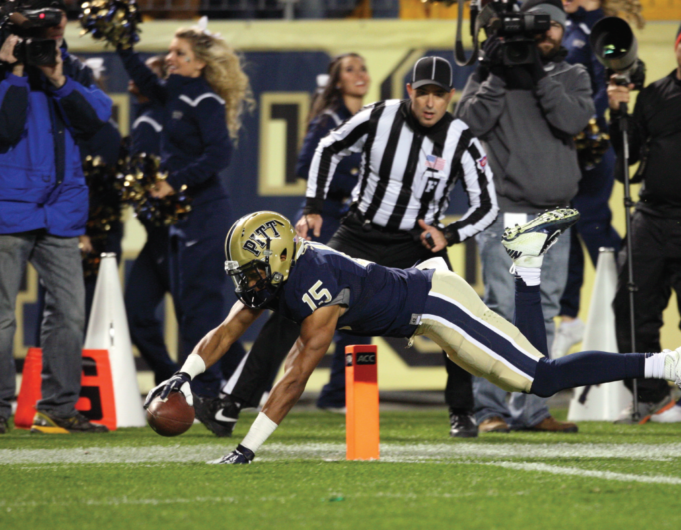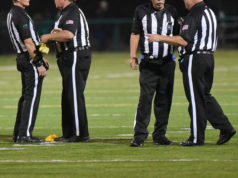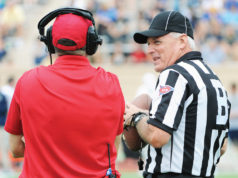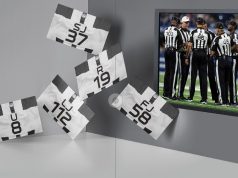Moving energetically, sometimes referred to as hustle, not only creates a positive perception, but it can help officials get where they need to be to call the play properly. Being in the right position is perhaps the most important aspect of officiating. Movement for the sake of demonstrating movement cannot only fail to make a meaningful contribution to calling the game, it can also be a detriment. It is difficult to observe discrete game action while running at full speed. Additionally, over-hustling can result in reduced coverage when the official overruns the optimal position from which to observe.
An official should have an intense dedication to being in the right position from which to view a play. Consequently, movement during live-ball action must not only be planned, but it must have a specific purpose. The key to proper movement is starting from an optimal position and getting a good start. If the initial position is good, then movement can be kept to a minimum i.e., minimal movement often results in maximum officiating.
Safety is a primary consideration in all sports. Officials must safeguard both players and themselves. An official who is scrambling to avoid contact (“running for his life”) cannot possibly see all that he needs to see. The concept of a good initial position is paramount for safety purposes. Purposeful movement can also be made to keep something within view and not necessarily to gain closer proximity. In many situations, the angle is more important than the distance. Here is a summary of purposeful movement for each position.
Back judge
The back judge starts 20-25 yards deep. As pass receivers flow downfield, he must retreat and keep a buffer of 10-15 yards from the nearest player. If anyone gets past the deep official, the mistake will be very visible.
On running plays, the back judge need not move until his buffer begins to dissolve. He will then move to maintain or restore his separation while keeping a watchful eye on the runner and the nearest potential tackler. When the ball is snapped outside team B’s 10 yardline, the back judge is responsible for the goalline and he must get there before the runner.
Wings
The wings must start and work off the field; that’s a safe place at least for a while. When the play ends the wings will generally pinch in as they mark the progress. Stopping at the nine-yard marks is the expected norm but when the ball is downed near the line-to-gain, at least one wing should go all the way to the ball. That indicates a decisive determination of the spot and the movement clearly has a purpose.
The greatest variations in how wings officiate a game occur during the play. Some officials will freeze as they read the blocks to determine pass or run. It’s better to shuffle a few steps downfield while reading the blocks. Most plays will gain yardage and those few initial steps can aid in keeping up with the play. If the play never goes beyond the line, the official is still close enough to retreat and cover it.
Observing the action from off the field is usually safe, but can become a risky proposition if the official finds himself in the path of the runner and his pursuers. Therein lies the importance of keeping the sideline clear so the official can step back as far as necessary. At some point, the sideline official must let the players pass by. If he shows how adeptly he can move by getting farther downfield than the players, someone will eventually run him over.
On long runs, especially breakaways for touchdowns, some wing officials see the play as a challenge to beat the runner to the goalline. While that might appear to be impressive, it is unlikely any officiating is accomplished. The back judge is responsible for the goalline and the sideline official is needed to watch the action behind the runner, which can be done from a trail position.
Referee
The referee should be 12-15 yards deep and at least as wide as the tight end; that will buy him some time to observe the blocking as the quarterback drops back into the pocket. That width allows him to cover the sideline before the quarterback can scramble there. His depth provides protection and ensures he doesn’t get too close to a play where action will explode on him. Like the back judge, the white hat must keep a buffer (if the quarterback drops back, so must the referee).
If the quarterback is sacked, the referee must briskly attend to him. His immediate presence will deter cheap shots while the quarterback is on the ground. When a run ends behind the line, the referee should be there quickly to help the umpire supervise the unpiling of players. If the quarterback rolls out away from the referee, he must trail the play and observe the action among the players in view. Attempting to pass up the quarterback or any other runner and beat them to the opposite sideline is generally futile.
After the play, there isn’t much value in the referee running to the line unless he needs to check for a first down or he needs to assist with the pile. If the ball is clearly short or beyond the line-to-gain, the line judge can give the referee the appropriate indication and the referee can signal it from the offensive backfield. The referee sharply moving away from players toward the press box to give foul signals so they may be more clearly viewed is movement with a purpose. After dead-ball officiating is complete, the referee should get into position before blowing the ready so he doesn’t have to hurry to get set before the snap.
Umpire
The umpire has limited options as he is in the most precarious position. A local umpire got knocked down in three successive games. A video review revealed he was planting himself immediately behind the defensive line and in front of the linebackers. Most manuals prescribe four to seven yards deep but the positions of the linebackers are a better gauge. The umpire must start behind them and at least two steps away.
When the play comes at the umpire, there is no surefire way to avoid contact. In some cases, it may make sense to freeze and let the players maneuver while in other scenarios the umpire must move. Most umpire movement during live-ball action consists of pivoting. An umpire must gauge the nature of a run through the line and should train himself to pivot out of the way. That is easy to say but often not easy to do, yet skillful and alert individuals are often able to skip out of harm’s way and not be caught in the crush of players.
On pass plays, the umpire must get to the line to rule on screen passes that may cross the line and on quarterbacks who cross the line before passing the ball. That movement is not as much about speed as it is about recognition of a pass play. In fact, it must be a purposeful move because the umpire must watch for holding as he moves to the line.
On punts, the umpire should start deeper; about 10 yards is ideal. Once the ball is kicked, linemen of both teams will abruptly turn to follow the ball and the umpire does not want to be in the area where the blind turns are made.
What's Your Call? Leave a Comment:
Note: This article is archival in nature. Rules, interpretations, mechanics, philosophies and other information may or may not be correct for the current year.
This article is the copyright of ©Referee Enterprises, Inc., and may not be republished in whole or in part online, in print or in any capacity without expressed written permission from Referee. The article is made available for educational use by individuals.


















